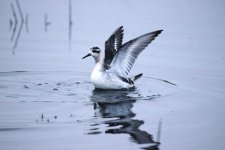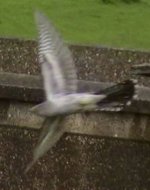It's a really interesting thread and it's good to see that others are facing the same dilemma I do nowadays in the field.
I'm a 450+ British lister. I've always wanted to have a record of what I've seen, and in the early days I'd buy someone else's photograph, and then moved on to direct video, then video down the scope, then digi-scoping to where I am now which is a half decent camera and lens, (60D with a Sigma 150-500). Not top of the range stuff but a kit which can take some decent shots, (well I think so - see blog:-O).
I am trying to get a shot of everything on my list. I have two massive 6x4 albums in Vous order with gaps where I've no shot. For me it's a constant process of improving on what I have. I'll take a record shot for the album but if the opportunity arises to get a better shot I'll go for it. There are some species where I'm really happy with the shot I have, and they are low priority. For many of the older ones I've taken a video grab and you can imagine these are really poor. Some say it spoils the album, and I've a mate who is doing the same thing, but won't put anything in unless it's of a certain quality.
The dilemma I have is birding -v- photography. First of all, I'm having to travel miles now for birds I've seen. Had it stuck the Desert Warbler would have been a good example. I saw the Flamborough and Easington birds, but have a poor video grab of the latter. Do I travel to Kent for a shot?
The other dilemma is I've always birded with my brother who has never caught the photography bug. So, we were all set to go for the Hooded Merg. which we both need last Sunday. Had we gone, we'd got a loose plan to go for the Ring-billed Gull and Red-breasted Goose as well. However, if we'd arrived at the HM and it was distant, I'd have wanted to give it as long as it took for it to come close, whereas my brother would have probably been ready to move on after grilling it through the scope for say half an hour to an hour max. Now I also need the Ring-billed, (currently decent shot but the Walpole bird offers more) and Red-breasted, (currently poor video shot). It's always a constant decision-making process. Is the HM rare enough to justify staying? Is the goose shot so poor I need to go? Am I being picky with my gull and the current shot is good enough for the album?
Then I'm now finding that the photography is taking over which I'm not comfortable with. I can have a day at Spurn in Autumn, (example) and see Red-breasted Fly, Greenish Warbler, Wryneck and Red-backed Shrike and come home disappointed because none offerd a decent opportunity for a shot. That's ridiculous because prior to the camera I'd have really enjoyed those birds.
Then, it's not enough for a record shot, you are trying to take a shot with the perfect pose and back-lighting etc.
So in summary for me it's a balancing act. I'd always prioritise seeing a lifer or Yorkshire list bird above a good shot, but sometimes it's do I go see a rarer bird that offers less photo opp. (recent distant Roller) or a common bird that will give good photo opp's. (say an inland diver or velvet scoter).
No easy answer but I will try to continue to combine the two as I love the end results at times even though it's probably spoiling my enjoyment of the hobby as a whole to some extent.





